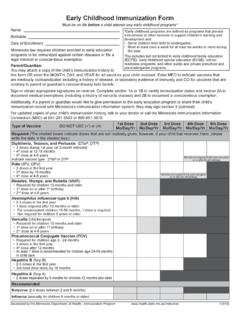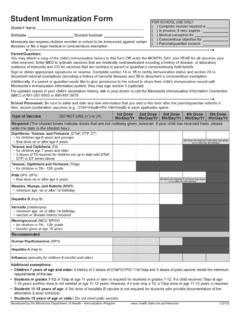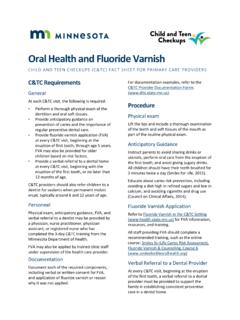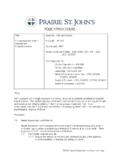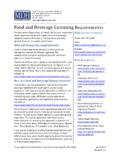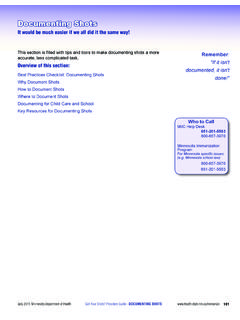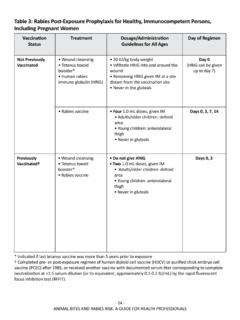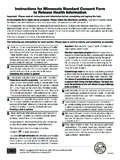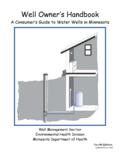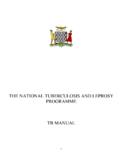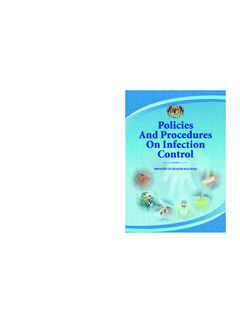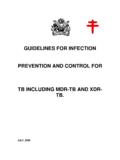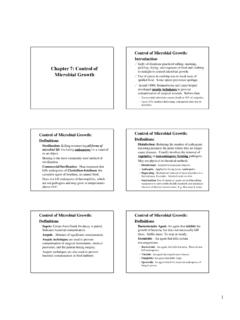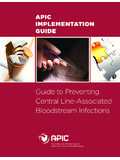Transcription of Regulations for Tuberculosis Control in Minnesota …
1 Regulations for Tuberculosis Control in Minnesota Health Care SettingsTuberculosis Prevention and Control ProgramPO Box 64975St. Paul, MN 55164-0975 Phone: 651-201-5414 or guide for implementing Tuberculosis (TB) infection Control Regulations in your facilityJuly 2013 Table of ContentsIntroduction .. 1 chapter 1. Background .. 3 Determining which Regulations to follow ..3 chapter 2. TB Infection Control Program .. 5TB infection Control team ..5 Facility TB risk assessment ..5 Written TB infection Control procedures ..6 HCW education ..7 chapter 3. Screening Health Care Workers (HCWs) .. 9 Defi nition of a HCW ..9 General principles ..10 Baseline TB screening ..10 Serial TB screening ..11 Special situationsHCW with signs or symptoms of active TB disease.
2 11 HCW with a newly-identifi ed positive TST or IGRA ..12 HCW with written documentation of a previous positive TST or IGRA ..13 HCW with verbal (undocumented) history of a previous positive TST or IGRA ..13 Pregnant HCW ..13 Conversions ..13 HCW with TST results between 5 and 9 mm of induration ..14 Students ..14 Volunteers ..14 HCW with previous history of severe adverse reaction to TST ..14 HCW refusal ..14 HCW who travels outside of the United States ..15 Baseline TB Screening Tool for HCWs ..16 Serial TB Screening Tool for HCWs ..18 Exemption Form for Tuberculin Skin Testing of a Pregnant HCW ..20 Information for Health Care Workers with Tuberculin Skin Test (TST) Results between 5 and 9 mm ..21 chapter 4. Screening Residents.
3 23 General principles ..23 Baseline TB screening of residents in boarding care homes and nursing homes ..23 Baseline TB screening of residents in residential hospices ..24 Special situationsResident with newly identifi ed positive TST or IGRA ..24 Resident with written documentation of previous positive TST or IGRA ..24 Resident with verbal (undocumented) history of previous positive TST or IGRA ..25 Residents with signs or symptoms of active TB disease ..25 Residents with previous history of severe adverse reaction to TST ..26 Resident refusal ..26 Baseline TB Screening Tool for Nursing Home and Boarding Care Home Residents ..27 Baseline TB Screening Tool for Residents in Residential Hospice ..29 Glossary .. 31 Regulations for Tuberculosis Control in Minnesota Health Care Settings July 2013 Page 1 The purpose of this manual is to assist health care facilities in Minnesota to understand what is needed to be in compliance with Minnesota laws revised in 2013 regarding TB prevention and Control , and to provide tools for implementing legal Regulations and best practices in their settings.
4 Minnesota laws governing Tuberculosis (TB) prevention and Control Regulations in health care settings (including TB screening of health care workers and residents) have historically consisted of a variety of separate rules written for specifi c settings at various times. Many of them were based on national recommendations published in the 1990s or earlier. In 2005, the Centers for Disease Control and Prevention (CDC) published revised guidelines* ( ). Since that time, the Minnesota Department of Health (MDH) has recognized that legal Regulations and best practices for TB infection Control in Minnesota needed to be revised to meet these guidelines and to incorporate current knowledge and technology. The TB waivers, issued by MDH on March 9, 2009, were an interim step in this process to address the outdated TB laws for boarding care homes, home care providers, nursing homes, and supervised living facilities.
5 The TB waivers stated that licensees were required to follow the 2005 CDC guidelines. As a fi nal step, MDH proposed new legislation in 2013, which was adopted by the Minnesota Legislature and takes effect on August 1, 2013. These laws are based on the 2005 national guidelines and replace the 2009 TB waivers. They apply to settings licensed by MDH, including boarding care homes, home care providers, hospices, nursing homes, outpatient surgical centers, and supervised living facilities. *Guidelines for Preventing the Transmission of Mycobacterium Tuberculosis in Health-Care Facilities, 2005. From CDC, MMWR, December 30, 2005, 54(RR17); for Tuberculosis Control in Minnesota Health Care Settings July 2013 Page 3 chapter 1 BackgroundDetermining which Regulations to followAll state-licensed or federally-certifi ed health care settings in Minnesota are required by law to follow certain measures to prevent and Control TB in their facilities.
6 In addition, facilities should follow the Regulations of the Minnesota Occupational Safety and Health Administration (MN-OSHA). (see Resources)There are three categories of Regulations related to TB:1. TB infection Control program2. Process for screening health care workers (HCWs)3. Process for screening residents This manual provides specifi c information about each type of regulation. To determine which of these Regulations apply to your facility, see the table below. If you are unsure what type of license your facility has, you can look it up at care settingTB infection Control program ( chapter 2) Screening HCWs ( chapter 3) Screening residents ( chapter 4)Regulatory authorityAssisted living facilityYesYesNoMinnesota Statutes, section , Subd.
7 11 Boarding care home (MDH licensed)Yes YesYesMinnesota Statutes, section , Subd. 2c2 Home care provider (MDH licensed)YesYes NoMinnesota Statutes, section , Subd. 11 Hospice (MDH licensed)YesYes Yes (residential hospice only) Minnesota Statutes, section , home (MDH licensed)Ye sYe sYe sMinnesota Statutes, section , Subd. 3b4 Outpatient surgical center (MDH licensed)YesYesNoMinnesota Statutes, section , Subd. 3c5 Page 4 July 2013 Regulations for Tuberculosis Control in Minnesota Health Care SettingsHealth care settingTB infection Control program ( chapter 2) Screening HCWs ( chapter 3) Screening residents ( chapter 4)Regulatory authoritySupervised living facility (MDH licensed)YesYesNoMinnesota Statutes, section , Subd.
8 6a6 Supplemental nursing services agency (MDH licensed)Education program onlyYe sN oMinnesota Statutes, section , Subd. 17 All other settingsYesYesNoMN-OSHA81 (search TB Directive)Background chapter 1 Regulations for Tuberculosis Control in Minnesota Health Care Settings July 2013 Page 5 chapter 2TB Infection Control Program All health care settings in Minnesota should have an up-to-date TB infection Control program that includes: A team responsible for TB infection Control A facility TB risk assessment Written TB infection Control procedures Health care worker (HCW) education TB infection Control teamIdentify a qualifi ed person or a team of persons in your facility and assign them primary responsibility and authority for TB infection Control .
9 This person or team will conduct your setting s facility TB risk assessment; develop, implement, and enforce TB infection Control policies (including HCW and resident TB screening); and ensure that HCWs receive adequate TB-related training and education. Facility TB risk assessmentThe facility TB risk assessment is a structured evaluation of a health care facility or setting s risk for transmission of M. Tuberculosis . The infection Control team determines the setting s TB risk classifi cation based on the results of the facility TB risk assessment. All health care settings in Minnesota should perform an initial facility TB risk assessment. Medium-risk settings should update their assessment yearly; low-risk settings should update theirs every other year.
10 Keep your facility s completed TB risk assessment worksheets on fi le for future reference. Your facility TB risk assessment should be conducted by your infection Control team. In general, one-assessment encompasses an entire setting. However, in certain settings it may be appropriate to do separate assessments for specifi c areas within the setting. Information on the number of TB cases by county for the previous year are posted on MDH s web site in May of each year. Risk assessments conducted early in the calendar year (before new data are posted) should use data from the previous year. Please do not contact MDH before May to obtain TB data for the previous one of the following three methods to conduct your risk assessment(s): 1.

